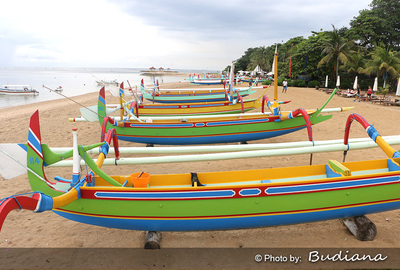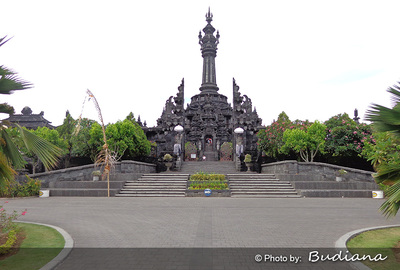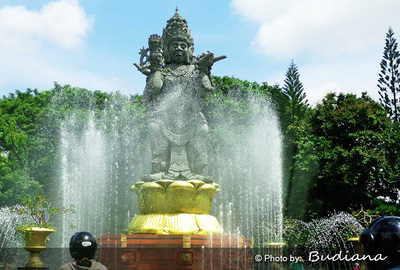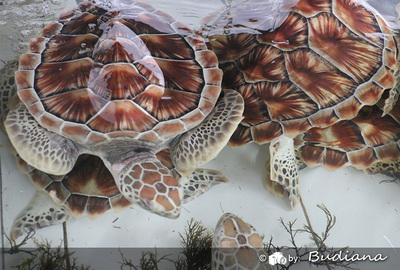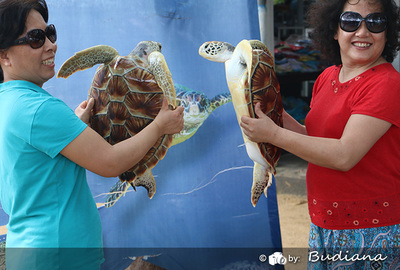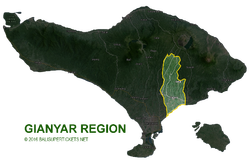Bali Museum: The largest collection of Baliana in the world is located on the east side of Taman Puputan on Jl. Mayor Wishnu just south of the tourist office. The Bali Museum was established in 1910 by the conquering Dutch, who sought to collect and preserve artifacts they felt were disappearing overseas or succumbing to the elements. In 1917, an eruption of Gunung Batur and subsequent earthquakes destroyed hundreds of Denpasar's buildings, including the museum. Rebuilt in 1925, it was used as a storehouse for artifacts and temporary exhibits until 1932, when it was established as an ethnographic museum. The German painter Walter Spies helped assemble many of its original treasures from private collections and donations.The grand, well-kept complex consists of a series of attractive, grassy courtyards containing all the archetypes of Balinese architecture—bale agung, candi bentar, kulkul. The main structure, with its many pillars, is built in the manner of Puri Kanginan in the eastern regency of Karangasem. Standing next to it is a reproduction of Singaraja Palace on the north coast. With rich ornamentation both inside and out, the museum's architecture combines the two principal edifices of Bali, the temple (pura) and the palace (puri).The museum's four buildings contain a splendid collection of Balinese art—Neolithic stone implements, a hoard of Buddhist clay seals excavated near Pejeng, Balinese folk crafts, carved and painted woodwork, cricket-fighting cages, dance costumes, textiles, masks, weaving looms and fabrics, agricultural tools, musical instruments, furniture, scale models of ceremonial events, ethnographic exhibits. The first pavilion is a two-story building containing high-quality, early traditional, Kamasan-style paintings; classical Balinese calendars; modern Batuan and Ubud-style paintings; and work of the Academic and Young Artists (or Naive) schools. Another pavilion displays carved media—wood, stone, clay, and bone—including sculpted windows, doors, pillars, ceiling beams, friezes, old guardian figures, demons, and specimens of Bali's extraordinarily earthy and vigorous folk art. The building, dedicated to prehistoric artifacts, displays Bronze Age implements, including the famous Gilimanuk bronze spearhead, the largest ever discovered in Southeast Asia. Also see ritual objects, priestly accoutrements, and a veranda lined with old stone statues. One building is devoted entirely to masks, weapons, and costumes of the performing arts, including rare barong pig masks and primitive dance masks from remote villages. There's also an incredible display of topeng. A good part of the displays are annotated with English explanations, and clear maps in the central building show all the important prehistoric and historical sites of Bali. The museum also has a library and a shop selling postcards and books in English. However, there's no ground plan of the museum nor is a guide available to show visitors around. Open Tues.-Thurs. 0800-1700, Friday 0800-1530, closed Monday. Admission Rp500. Wear long pants.
Jagatnatha Temple: Just east of the big alun-alun on Jl. Mayor Wishnu, next to the museum, is a Hindu temple, Jagatnatha Temple, built in 1953. In the afternoon, people from the surrounding kampung come here to pray; the temple's especially busy during the full moon. On a towered throne of white coral sits a bright, gold statue of Ida Batara Sanghyang Widhi in his typical pose. This is the supreme god of Balinese Hinduism. The padmasana rests on the back of the sacred turtle, clasped by two naga on plinths carved with scenes from the Mahabharata and Ramayana. The central courtyard is surrounded by a moat containing gigantic carp.
Pemecutan Palace (Puri Pemecutan): Puri Pemecutan near Tegal bus station on the corner of Jl. Thamrin and Jl. Hasannudin, built in 1907 to replace the original palace of the raja destroyed by Dutch artillery. Pemecutan, which shares the complex with Pemecutan Palace Hotel, houses old weapons and a renowned gamelan mas which survived from the original puri. Don't miss the handsome, four-tiered kulkul diagonally opposite the palace with its eight small raksasa statues. Chinese porcelain plates decorate the topmost tier.
Puputan Square: A great place for families to hang out in the evenings is the huge, well-kept park in the middle of town, named for the bloody 1906 extermination of the island's ruling class by the Dutch. An heroic-style monument facing Jl. Surapati commemorates this tragic event. Note the woman with the kris in one hand and jewels in the other. Eyewitnesses of the time reported that female members of the court tauntingly flung their jewelry at the Dutch troops before being mowed down by rifle fire.On every side of Taman Puputan are the traditional symbols of the power elite. North of the square is the Governor's Residence, built in Javanese pendopo style. Facing the Bali Museum is the stolid, modern military headquarters complex. Just south of the square in the middle of the city's busiest intersection is a five-meter-high, four-faced, eight-armed statue—Mukha, representing Batara Guru, "God of the Four Directions," who is even-handedly blessing all the cardinal points simultaneously.
Sanur: Sanur area is the oldest tourism village in this area, where the first five star rated hotel was built. Its know for its luxurious and quiet area for tourists. It beautiful beaches and sun rise view make Sanur becomes one of the popular tourist destination in this world. Even you can see the memorable Le Mayur museum in its beach side.
The Art Center: Also called Taman Werdi Budaya, the Art Center is on Jl. Nusa Indah in Abiankapas, a suburb of Denpasar in the direction of Sanur, only a 15-minute walk east of Kereneng station. Set in a restful garden with lotus ponds amid richly carved baroque Balinese buildings, the Taman Werdi Budaya houses exhibits of modern painting, masks, and woodcarving. Both Balinese and Indonesian artists are featured. You'll find a car park, museum, and small, fixed-price handicraft shops.Visitors can view dance and music rehearsals in two open-air amphitheaters with modern lighting. Dances are also regularly staged for the public, including works incorporating modern Balinese choreography. In the kecak performance, staged each night 1830-1930 (Rp5000), traditional flickering oil lamps are still used. Eerie and powerful.The Art Center also hosts a summer art festival each year from mid-June to mid-July, with competitions for costumes, dance, drama, sendratari performances, music, woodcarving, metalworking, and food. Every year is different, with each of Bali's regencies sending its best teams. Also see art events, crafts exhibits, and an extravagant production of the Ramayana Ballet. If it's the high season, be sure to book your hotel in advance. These entertaining and exciting cultural shows draw tens of thousands of visitors from around the world.The Balinese Art Development Center Program, Jl. Bayusuta (in the Art Center), is open 0800-1700 daily except Monday. This tertiary-level institute offers work on the undergraduate through master's degree levels. Besides staging dances, plays, and pop concerts, it houses permanent exhibits offering handicrafts, paintings, carvings, and silver. Student discounts available.
Jagatnatha Temple: Just east of the big alun-alun on Jl. Mayor Wishnu, next to the museum, is a Hindu temple, Jagatnatha Temple, built in 1953. In the afternoon, people from the surrounding kampung come here to pray; the temple's especially busy during the full moon. On a towered throne of white coral sits a bright, gold statue of Ida Batara Sanghyang Widhi in his typical pose. This is the supreme god of Balinese Hinduism. The padmasana rests on the back of the sacred turtle, clasped by two naga on plinths carved with scenes from the Mahabharata and Ramayana. The central courtyard is surrounded by a moat containing gigantic carp.
Pemecutan Palace (Puri Pemecutan): Puri Pemecutan near Tegal bus station on the corner of Jl. Thamrin and Jl. Hasannudin, built in 1907 to replace the original palace of the raja destroyed by Dutch artillery. Pemecutan, which shares the complex with Pemecutan Palace Hotel, houses old weapons and a renowned gamelan mas which survived from the original puri. Don't miss the handsome, four-tiered kulkul diagonally opposite the palace with its eight small raksasa statues. Chinese porcelain plates decorate the topmost tier.
Puputan Square: A great place for families to hang out in the evenings is the huge, well-kept park in the middle of town, named for the bloody 1906 extermination of the island's ruling class by the Dutch. An heroic-style monument facing Jl. Surapati commemorates this tragic event. Note the woman with the kris in one hand and jewels in the other. Eyewitnesses of the time reported that female members of the court tauntingly flung their jewelry at the Dutch troops before being mowed down by rifle fire.On every side of Taman Puputan are the traditional symbols of the power elite. North of the square is the Governor's Residence, built in Javanese pendopo style. Facing the Bali Museum is the stolid, modern military headquarters complex. Just south of the square in the middle of the city's busiest intersection is a five-meter-high, four-faced, eight-armed statue—Mukha, representing Batara Guru, "God of the Four Directions," who is even-handedly blessing all the cardinal points simultaneously.
Sanur: Sanur area is the oldest tourism village in this area, where the first five star rated hotel was built. Its know for its luxurious and quiet area for tourists. It beautiful beaches and sun rise view make Sanur becomes one of the popular tourist destination in this world. Even you can see the memorable Le Mayur museum in its beach side.
The Art Center: Also called Taman Werdi Budaya, the Art Center is on Jl. Nusa Indah in Abiankapas, a suburb of Denpasar in the direction of Sanur, only a 15-minute walk east of Kereneng station. Set in a restful garden with lotus ponds amid richly carved baroque Balinese buildings, the Taman Werdi Budaya houses exhibits of modern painting, masks, and woodcarving. Both Balinese and Indonesian artists are featured. You'll find a car park, museum, and small, fixed-price handicraft shops.Visitors can view dance and music rehearsals in two open-air amphitheaters with modern lighting. Dances are also regularly staged for the public, including works incorporating modern Balinese choreography. In the kecak performance, staged each night 1830-1930 (Rp5000), traditional flickering oil lamps are still used. Eerie and powerful.The Art Center also hosts a summer art festival each year from mid-June to mid-July, with competitions for costumes, dance, drama, sendratari performances, music, woodcarving, metalworking, and food. Every year is different, with each of Bali's regencies sending its best teams. Also see art events, crafts exhibits, and an extravagant production of the Ramayana Ballet. If it's the high season, be sure to book your hotel in advance. These entertaining and exciting cultural shows draw tens of thousands of visitors from around the world.The Balinese Art Development Center Program, Jl. Bayusuta (in the Art Center), is open 0800-1700 daily except Monday. This tertiary-level institute offers work on the undergraduate through master's degree levels. Besides staging dances, plays, and pop concerts, it houses permanent exhibits offering handicrafts, paintings, carvings, and silver. Student discounts available.





